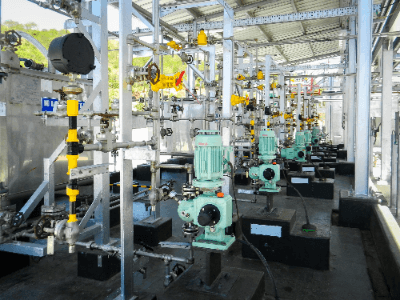What Is a Chemical Pump?

Chemical Pumps are used to transport liquids such as chemicals.
Unlike ordinary pumps, Chemical Pumps are required to be corrosion and abrasion resistant. Like ordinary pumps, they suck up liquid and pump it into pipes or tanks.
The rotating parts inside the pump are made of wear- and corrosion-resistant materials such as ceramics and stainless steel to prevent damage caused by chemicals. These pumps have the characteristics necessary for transporting chemicals, and it is important to select the appropriate product for each type.
Applications of Chemical Pumps
Chemical Pumps are used in a variety of industrial fields:
1. Chemical Plants and Other Factories
Chemical Pumps are indispensable equipment for chemical plants and other factories. Chemical plants manufacture a wide variety of chemicals, and ordinary pumps cannot handle highly corrosive and toxic chemicals. Therefore, the use of Chemical Pumps prevents corrosion and contamination and ensures the safety of the plant.
2. Water Treatment Facilities
At water treatment facilities, chemicals must be added to purify sewage. By using Chemical Pumps, the amount of chemicals to be added can be accurately controlled, leading to more efficient purification processes.
3. Medical Field
Chemical Pumps are used to supply chemicals used in dialysis machines, etc. Chemical Pumps are also used in the manufacturing process of medical devices to transport a variety of liquids.
Principles of Chemical Pumps
1. When Centrifugal Force Is Used
Liquid is sucked between the rotating shaft and the impeller and is then pushed out into the casing by rotation. The pressurized liquid is discharged with a lift. The pump consists of a pump head made of a material matched to the properties of the liquid and a rotating impeller attached to a rotating shaft.
2. Using Cylinder Pressurization
Specialized for metering small volumes of liquid, this pump uses the movement of a piston to meter liquids. It can measure liquids with a high degree of accuracy and is used in the medical and research fields.
The power source can be electric, air-driven, or manual. Electric or air-driven machines have high operating efficiency and stability, and can efficiently transport liquids. On the other hand, manual pumps can be used in places where there is no power source and are suitable for simple conveyance of liquids.
Types of Chemical Pumps
There are various types of Chemical Pumps. The following are examples of chemical pumps:
1. De-aerating Pump
This pump is capable of pumping liquid while removing foam from the liquid. Degassing is possible without the use of a de-aerating agent. Also called degassing pumps, these pumps use a pump head specially designed to break up foam.
2. Process Pumps
Process pumps are used in applications such as chemical plants that require high pressures and flow rates. The pump head is made of high quality alloy steel and has high corrosion resistance. The rotating parts are made of wear-resistant materials such as ceramics and carbon.
3. Low Pulsation Pump
Low pulsation pumps are used to stabilize liquid flow. The pump’s extremely smooth motion allows the liquid to be pumped without flow fluctuations. They are suitable when high precision is required, such as in the medical and research fields.
4. Handy Chemical Pump
This is a portable pump that can suction liquids from drums, pails, etc. using a suction pipe. It is used for transferring liquids such as organic solvents and chemicals.
Explosion-proof Chemical Pumps that can handle flammable and explosive liquids with anti-static designs are also available. In addition, there are flow-adjustable type Chemical Pumps that can adjust the flow rate by means of a changeover switch.
5. Submersible Chemical Pumps
Chemical Pumps that can be used underwater are also available. Both resin and metal pump materials exist. They are used for small chemical dispensing and liquid transfer in wastewater pits.